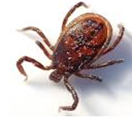Safety
Biological Hazard Safety Tips: Ticks/Chiggers
PROTECT YOURSELF FROM TICK/CHIGGER (RED BUG) BITES:
- Know where to expect ticks. Ticks live in moist and humid environments, particularly in or near wooded or grassy areas. You may come into contact with ticks during outdoor activities around your home or when walking through vegetation such as leaf litter or shrubs. Always walk in the center of trails, in order to avoid ticks.
- Use a repellent with DEET (on skin or clothing) or permethrin (on clothing only) and wear long sleeves, long pants and socks. Products containing permethrin can be used to treat boots, clothing and camping gear which can remain protective through several washings. Repellents containing 20% or more DEET (N, N-diethyl-m-toluamide) can be applied to the skin, and they can protect up to several hours. Always follow product instructions!
- Wear light-colored clothing, which allows you to see ticks crawling on your clothing.
- Tuck your pant legs into your socks so that ticks cannot crawl up inside of your pant legs. Some ticks can crawl down into shoes and are small enough to crawl through most socks. When traveling in areas with lone star ticks (which are associated with Southern tick-associated rash illness, ehrlichiosis, and possibly Rocky Mountain spotted fever) you should examine your feet and ankles to ensure that ticks are not attached.
- Conduct a tick check. When you come out of the field, check your clothes carefully and examine your skin in detail. Check those little places, your bellybutton, back of your ear, etc.
- Permethrin, which is available commercially as two or three different products and comes in a thin solution that can be washed into your clothing, is recommended by some agencies. But read the instructions carefully; Permethrin is a pesticide and you don’t want to expose yourself to its dangers unnecessarily.
Check your body for ticks after being outdoors, even in your own yard. Conduct a body check upon return from potentially tick-infested areas by searching your entire body for ticks. Use a hand-held or full-length mirror to view all parts of your body and remove any tick you find. Check these parts of your body and your child’s body for ticks:
- Under the arms
- In and around the ears
- Inside belly button
- Back of the knees
- Under the arms
- In and around the hair
- Between the legs
- Around the waist
Check your clothing for ticks. Ticks may be carried into the house on clothing. Both should be examined carefully, and any ticks that are found should be removed. Placing clothes into a dryer on high heat effectively kills ticks.
TICK REMOVAL:
- Remove an attached tick as soon as you notice it. Watch for signs of illness such as rash or fever, and see a health care provider if these develop. For detailed information about tick removal, see the Rocky Mountain spotted fever Web site.
- Your risk of acquiring a tick-borne illness depends on many factors, including where you live, what type of tick bit you, and how long the tick was attached. If you become ill after a tick bite, see a health care provider.
- Remove it with tweezers or tick pliers place as close to the skin as possible. Pull slowly and steadily to ease out the mouth parts; these may be anchored in your skin and will break off if you pull too quickly. Don’t squeeze the tick body as you pull it off; that could inject bacteria into your body.
TREATMENTS FOR CHIGGER BITES:
- Take a bath or shower as soon as possible after any possible exposure to chiggers.
- Apply an anti-itch medication: hydrocortisone, Calamine Lotion, Oatmeal, etc…
- Oral Benadryl pills or liquid form (Consult with your personal physician before taking any medications)
- By: Debbie Vance
- Title, Organization here
- on
Archives
Biological Hazard Safety Tips: Ticks/Chiggers
June 6, 2023


